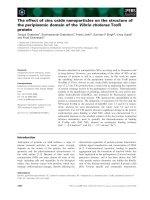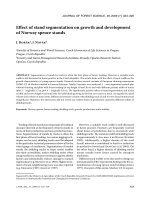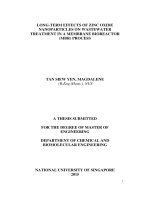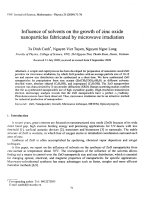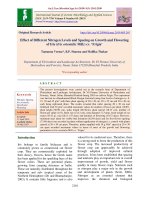Effect of zinc oxide nanoparticles on growth and development of dendrobium officinale kimura et migo in in vitro culture medium
Bạn đang xem bản rút gọn của tài liệu. Xem và tải ngay bản đầy đủ của tài liệu tại đây (662.1 KB, 6 trang )
HNUE JOURNAL OF SCIENCE
Natural Sciences, 2020, Volume 65, Issue 4A, pp. 21-26
This paper is available online at
EFFECT OF ZINC OXIDE NANOPARTICLES ON GROWTH
AND DEVELOPMENT OF Dendrobium officinale KIMURA ET MIGO
IN IN VITRO CULTURE MEDIUM
Dao Thi Sen * and Le Thi Thuy
Faculty of Biology, Hanoi National University of Education
Abstract. Zinc-oxide nanoparticles (ZnO-NPs) has positive effects on the growth and
development of plants at appropriate concentrations. This study aimed to test the effect of
ZnO nanoparticles with concentrations from 0 mg/L to 5 mg/L individually or in
combination with ZnSO4 on growth and development of in vitro Dendrobium officinal at 3
stages of shoot multiplication, elongation and rooting. Results showed that zinc oxide
nanoparticles had the effect on stimulating shoot formation of in vitro Dendrobium officinal
at 1 mg/L to 5 mg/L. In shoot extension stage, zinc oxide nanoparticles stimulated length of
shoots. The medium formula with the addition of 1 mg/L zinc oxide nanoparticles and
combination with ZnSO 4 obtained the best results after 6 weeks of culture with 2.9
shoots/sample, average length of 2.74 cm/sample, total chlorophyll content of 545.8 µg/g.
ZnO nanoparticles was used at concentration of 1 mg/L, the root count was the most,
reaching 6.7 roots/sample with large and long roots. The basic MS control medium
(containing full zinc salts) produced lower or similar all tested mediumin some indicators
(2.5 shoots/sample after 6 weeks, shoot length of 2.58 cm/sample, total chlorophyll content
of 396.27 µg/g, large roots, reaching 3.5 roots/shoot).
Keywords: Dendrobium officinale Kimura et Migo, ZnO nanoparticles, growth and
development, chlorophyll.
1. Introduction
Nanotechnology is one of the important areas for investigation in sciences of modern
materials based on nanoparticle (NP) properties that are specific such as size, shape, and
distribution. Nanoparticles (NPs) have diverse properties when compared to respective
chemicals due to their structure, surface to volume ratio, morphology, and reactivity. In plant
tissue culture, there are several research based on the use of NPs in seed germination, plant
growth improvement, plant genetic modification, plant protection, improve bioactive compound
production and some others [1, 2]. The effectiveness of NPs on growth and development of
plant in plant tissue cultures depends on their dimensions, size, distribution, and type. Among
the metal nanoparticles, zinc oxide (ZnO-NPs) is the third most popular metal nanoparticle. Zinc
plays a vital role in physiological and anatomical responses so ZnO NPs are mostly used in
agricultural applications. Some of recent studies have evaluated the addition and replacement of
nano zinc oxide for commonly used zinc salts that indicate positive inputs. Chamani et al.
reported the accumulation of specific bioactive compounds in Lilium ledebourii and its dependency
Received April 13, 2020. Revised May 4, 2020. Accepted May 11, 2020
Contact Dao Thi Sen, e-mail address:
21
Dao Thi Sen and Le Thi Thuy
on the concentration of ZnO NPs in the MS medium. The highest content of flavonoids,
phenolics and anthocyanins was obtained on MS medium supplemented with 25, 75 and 100 mg
L−1 ZnO NPs, respectively. The accumulation of steviol glycosides in shoot cultures of S. rebaudiana
was significantly enhanced on MS medium fortified with 1 mg L−1 ZnO [3]. In addition, the
total flavonoid and phenolic content also increased with ZnO treatment [4]. However, higher
concentrations of ZnO led to decreased secondary metabolite production due to the phytotoxic
effects of ZnO. Treatment of licorice seedlings with copper oxide (CuO) and zinc oxide (ZnO)
increased the content of anthocyanins, flavonoids, glycyrrhizin, phenolic compounds and
tannins [5]. In general, the effects of nanoparticles depend on the type of nanoparticle, the plant
species, the duration of exposure and the concentration of nanoparticles used.
Micropropagation is one of the major applications of plant tissue culture. Flowering plants,
medicinal plants are often the subjects of choice. Dendrobium officinale Kimura et Migo spreads in
several countries over the world. This is a valuable medicinal plant that is interested in in vitro
cultivation. Few studies have been carried out to determine the effects of ZnONPs on growth
and development of some plant species. However, there has not been any research to determine
the effect of ZnO-NPs on in vitroDendrobium officinale growth and development.
2. Content
2.1. Materials and methods
2.1.1. Materials
ZnO-NPs with size of 20 - 40 nm, purity of 97% are provided by the Institute of Environmental
Technology - Vietnam Academy of Science and Technology. Concentrations of ZnO-NPs: 0; 0.1; 0.5;
1; 5 (mg/L).
Shoots of 1.0 cm in length from in vitro cultured Dendrobium officinale at Gennetics Biochemistry Department, Hanoi National University of Education were used in this study.
Culture media:
Shoot multiplication media: MS basal medium (Murashige and Skoog) or MS modified medium
(NZn: remove zinc salt completely and N1/2Zn: keep half of the zinc salt) supplemented with 0.3
mg/L BAP + 0.3 mg/L Kinetin + 0.1 mg/L NAA + 100 ml/L coconut water + 100 g/L potato
homogenate + 30 g/L sucrose + 7 g/L agar, pH 5,7 - 5,8 + ZnO-NPs (0; 0.1; 0.5; 1; 5 mg/L).
Root formation media: MS basal medium (Murashige and Skoog) or MS modified medium
(NZn: remove zinc salt completely and N1/2Zn: keep half of the zinc salt) supplemented with 1.0
mg/L IBA + 100 ml/L coconut water + 100 g/L potato homogenate + 20 g/L sucrose + 7 g/L agar +
0.1% activated carbon, pH 5,7 - 5,8 + ZnO-NPs (0; 0.1; 0.5; 1; 5 mg/L).
2.1.2. Methods
Effect of ZnO-NPs on shoot multiplication
Shoot of in vitro Dendrobium officinale (1cm) was used to culture into the above shoot
multiplication medium. The study was carried out to evaluate the effect of different
concentrations of ZnO-NPs on shoot multiplication and development of in vitro Dendrobium
officinale.
After 3 weeks and 6 weeks of culture, effects of ZnO-NPs to Shoot of in vitro Dendrobium
officinale on shoot multiplication were evaluated by the number of shoots/explant, shoot length
(cm), shoot morphology, % dry weight / fresh weight, and total chlorophyll content (mg/g).
Effect of ZnO-NPs concentrations on root formation.
22
Effect of zinc oxide nanoparticles on growth and development of in vitro Dendrobium…
After 3 weeks and 6 weeks of culture, shoots were separated and subcultured on rooting
medium. The effect of various concentrations of ZnO-NPs on root formation and development
of in vitro Dendrobium officinale was evaluated by number of roots/plantlet, root morphology.
Experimental arrangement
The experiments were repeated three times, each formula consisting of three flasks, five
samples/flask.
Statistical analysis
The results were indicated as means ± standard error of the mean (SEM). Comparisons of
variables were carried out by using Student’s t test or analysis of variation (ANOVA) with
Duncan’s multiple-range examination. Differences were considered to be significant when P < 0.05.
2.2. Results and discussion
2.2.1. Effect of ZnO-NPs on multiple shoot formation
The results of in vitroDendrobium officinale shoots after 3 weeks of culture on shoot
multiplication showed in Table 1.
Table 1. Effect of ZnONPs on multiple shoot formation after 3 weeks
Treatme
nt
No. of
shoots/
explant
Shoot
length
(cm)
Shoot
morphology
Treatme
nt
No. of
shoots/
explant
Shoot
length
(cm)
Shoot
morphology
NZn0
1.40a±0.14
1.36a±0.08
small, short,
green
N½Zn0
1.50a±0.14
1.41a±0.05
small, short,
green
NZn0.1
1.40a±0.28
1.42a±0.04
small, short,
green
N½Zn0.1
1.55 a±0.07
1.71ab±0.08
big, long,
green
NZn0.5
1.50ab±0.14
1.56ab±0.05
big, long,
green
N½Zn0.5
1.75 ab±0.21
1.82ab±0.19
big, long,
green
NZn1
1.70ab±0.14
1.67ab±0.11
big, long,
green
N½Zn1
2.25 b±0.21
1.94b±0.12
big, long,
green
NZn5
2.20b±0.28
1.82b±0.19
big, long,
green
N½Zn5
1.65a±0.07
1.73ab±0.11
big, long,
green
MS
1.55ab±0.21
1.62ab±0.04
big, long,
green
MS
1.55 a±0.21
1.62ab±0.04
big, long
green
Note. The same letters in lowercase in the same row mean no significant difference at P ≤ 0.05
There was a significant difference in the average number of shoots/explant in experimental
formulas and control formula. When ZnO-NPs was added into the cuture medium, it made the
positive respone on shoot initiation, number and growth rate of shoot. As the concentration of
ZnO-NPs added to the medium increased, the rate of shoot formation of the samples increased
significantly in both types of NZn and N½Zn media. In N½Zn medium, the formula N½Zn5 (5
mg/L ZnO-NPs) was the average number of shoots tends to decrease. However, there was no
significant difference between the sample and the control.
We further evaluated these criteria of shoot culture multiple shoot formation after 6 weeks.
Shoot of in vitro Dendrobium officinale were evaluated by the number of shoots/explant, shoot
length (cm), shoot morphology, % dry weight / fresh weight, and total chlorophyll content
(mg/g). The results were shown in Figure 1 and Table 2.
23
Dao Thi Sen and Le Thi Thuy
When ZnO-NPs addition to the medium increased (except N1/2Zn5), not only on No. of
shoots/explant, shoot length increased but total chlorophyll content and % dry weight/fresh
weight also increased). The explants on N1/2Zn medium with 1mg/L ZnO-NPs gained the
maximum number of shoots (2.90), highest shoot length (2.74 cm). These parameters were
about 10% higher than those of explants cultured on MS control medium, especially, total
chlorophyll content was 13.88% higher (545.80/396.27 µg/g). However, the data recorded about
% dry weight/fresh weight treatment was no significantly different between experiments (p
<0.05). In brief, the medium formula N1/2Zn 1 (removes 1/2 zinc salt and adds 1mg/L ZnONPs) was found to be the optimum concentration required to induce maximum shoot growth.
Table 2. Effect of ZnONPs on chlorophyll content and% Dry weight/Fresh weight after 6 weeks
Treatment
Chlorophyll a
content (µg/g)
Chlorophyll b
content (µg/g)
Total
chlorophyll
content (µg/g)
% Dry
weight/Fresh
weight
NZn0
91.60a±11.93
134.03a±13.32
225.64a±24.50
10.42%a±1.30
NZn 0.1
110.67ab±4.17
164.11ab±18.61
274.80ab±32.79
10.32%a±0.66
NZn 0.5
132.51ab±13.61
197.74ab±20.02
330.25ab± 3.63
10.26%a±1.07
NZn 1
144.43ab±24.33
213.84ab±34.09
358.28ab±58.42
9.86% a ±1.35
NZn 5
164.70b±22.86
243.13b±33.66
407.84b±56.51
9.51% a ±0.43
ĐC
159.42b±5.30
236.84b±5.77
396.27b±11.08
9.97% a ±0.66
N½Zn0
92.89a±17.21
194.02a±34.28
286.91a ± 51.49
10.70%a±0.70
N½Zn0.1
113.62ab±20.02
240.96ab±39.20
354.58ab±59.24
9.85% a±1.34
N½Zn0.5
153.92bc±17.14
324.46bc±43.64
478.38bc±60.78
9.70% a±0.84
N½Zn1
176.40c±5.72
369.29c±10.83
545.80c±16.56
9.68% a±0.59
N½Zn5
156.97bc±16.58
326.61bc±37.01
483.59bc±53.60
9.70% a±0.70
ĐC
159.42bc±5.30
236.84ab±5.77
396.27ab±11.08
9.78% a±1.24
Note: The same letters in lowercase in the same row mean no significant difference at P ≤ 0.05
Figure 1. Effect of ZnONPs on multiple shoot formation after 6weeks
The obtained results were consistent with the role of zinc and also showed the effects of
Zn-NPs outstanding compared to zinc salts. The primary sources of zinc micronutrients for
fertilizer fortification or types of plant tissue culture media are zinc oxides (ZnO) and zinc
sulfates (ZnSO4 H2O or ZnSO4.7H2O). Zinc is contained in most enzymes, necessary for
hormones and chlorophyll regulation, and for carbohydrate metabolism. In the nanoparticles
form, ZnO can be absorbed, metabolized and accumulated in plant systems. Zinc is a
micronutrient and therefore needed in small quantity; higher concentrations of ZnO NPs can
24
Effect of zinc oxide nanoparticles on growth and development of in vitro Dendrobium…
harm the development of plants, leading to inherent aberration in seed germination, root growth
and seedling biomass [6]. In this study, when the Zn-NPs concentration increased to 5 mg/L,
shoot formation, shoot extension and total chlorophyll content decreased. Javed et al (2017)
reported that the highest frequency of shoot formation (89.6%) was obtained when nodal
explants of Stevia rebaudiana were cultured on MS medium amended with 1 mg/L ZnO-NPs [7].
This result was similar to the result we obtained on Dendrobium officinale.
2.2.2. Effect of ZnO-NPs on root formation
The results of in vitro Dendrobium officinale shoots after 6 weeks of culture on root
formation showed in Table 3 and Figure 2.
Table 3. Effect of ZnO-NPs on root formation after 6 weeks
Treatment
No. of roots/
explant
Shoot
morphology
Treatment
No. of roots/
explant
Shoot
morphology
NZn0
3.75a±0.21
small, short
N½ Zn0
3.85 ab±0.07
small, short
NZn0.1
ab
4.20 ±0.28
b
big, long
N½Zn0.1
ab
big, long
b
4.40 ±0.28
NZn0.5
5.10 ±0.14
big, long
N½Zn0.5
4.75 ±0.21
big, long
NZn1
6.70c±0.42
big, long
N½Zn1
3.95 ab±0.07
big, long
NZn5
ĐC
ab
4.20 ±0.14
a
3.55 ±0.35
big, long
N½Zn5
big, long
ĐC
a
big, long
a
big, long
3.50 ±0.42
3.55 ±0.35
Note: The same letters in lowercase in the same row mean no significant difference at P ≤ 0.05
ZnO-NPs not only induced shoot multiplication but also influenced root formation of
explant. More roots were produced in explants inoculated on medium containing ZnO-NPs
solution in concentrations from 0.1 to 1 mg/L. It was also observed that in vitro shoot cultures
on NZn1 formula containing 1 mg/L ZnO-NPs produced maximum number of roots (6.70) per
explant with big, long roots. Number of roots/ explant and root morphology were the lowest and
worst in Zinc-free culture media (NZn0) and control medium (MS).
NZn5
N½Zn1
MS
Figure 2. Effect of ZnO-NPs on root formation after 6 weeks
Zinc is essential for the normal, healthy growth of plants. Plant usually requires small
amounts of Zn to allow the normal function. Many kinds of enzyme require Zn so Zn affects to
the metabolism of proteins, carbohydrates and auxin as well as reproductive processes [8]. So
Zn-deficient plants may be affect the process of root formation and development as well as
susceptibility to root diseases.
3. Conclusions
Zinc oxide nanoparticles had the effect on stimulating shoot formation of in vitro
Dendrobium officinal at 1 mg/L to 5 mg/L.In shoot extension stage, zinc oxide nanoparticles
stimulated length of shoots. The medium formula with the addition of 1 mg/L zinc oxide
25
Dao Thi Sen and Le Thi Thuy
nanoparticles and combination with ZnSO4 obtained the best results after 6 weeks of culture
with 2.9 shoots/sample, average length of 2.74 cm/sample, total chlorophyll content of 545.8
µg/g.ZnO nanoparticles was used at concentration of 1 mg/L, the root count was the most,
reaching 6.7 roots/sample with large and long roots. The basic MS control medium (containing
full zinc salts) produced lower or similar all tested mediumin some indicators (2.5
shoots/sample after 6 weeks, shoot length of 2.58 cm/sample, total chlorophyll content of
396.27 µg/g, large roots, reaching 3.5 roots/shoot).
Acknowledgments. The study was conducted with the financial supp ort from SPHN 18-02
TD project.
REFERENCES
[1] Wang X, Yang X, Chen S, Li Q, Wang W, Hou C, Gao X, Wang L, Wang S, 2016. Zinc
Oxide Nanoparticles Affect Biomass Accumulation and Photosynthesis in Arabidopsis.
Frontiesin Plant Science. Vol. 6, pp.1243-1255. DOI: 10.3389/fpls.2015.01243.
eCollection 2015.
[2] Ruttkay‑Nedecky B, Krystofova O, Nejdl L, Adam V, 2017. Nanoparticles based on
essential metals and their phytotoxicity. Journal of Nanobiotechnology. DOI 10.1186/
s12951‑017‑0268‑3.
[3] Chamani E, Ghalehtaki SK, Mohebodini M, Ghanbari M, 2015. The effect of Zinc oxide
nano particles and Humic acid on morphological characters and secondary metabolite
production in Lilium ledebourii Bioss. Iranian Journal of Genetics and Plant
Breeding, Vol. 4, pp. 11-19.
[4] Javed R, Usman M, Yücesan B, Zia M, Gürel E, 2017. Effect of zinc oxide (ZnO)
nanoparticles on physiology and steviol glycosides production in micropropagated
shoots of Stevia rebaudiana Bertoni. Plant Physiology Biochemistry, Vol. 110, pp. 94-99.
[5] Torney F, Trewyn BG, Lin VS, Wang K, 2007. Mesoporous silica nanoparticles deliver
DNA and chemicals into plants. Nature Nanotechnology, Vol. 2, pp. 295-300.
[6] Singh NB, Amist N, Yadav K, Singh D, Pandey JK, Singh SC, 2013. Zinc Oxide
Nanoparticles as Fertilizer for the Germination, Growth and Metabolism of Vegetable
Crops. Journal of Nanoengineering and Nanomanufacturing, Vol. 3, pp. 353-364.
[7] Tejaswi Thunugunta, Lakshmana Reddy DC., Aswath C, Shivashankara KS, Laxman RH,
Satisha GC, 2018. Impact of Zinc oxide nanoparticles on eggplant (S.melongena): Studies
on growth and the accumulation of nanoparticles. IET Nanobiotechnology, 12 (6) DOI:
10.1049/iet-nbt.2017.0237
[8] Römheld, V., Marschner, H. 1991. Function of micronutrients in plants. In: Mortvedt, J.J.,
Cox, F.R., Shuman, L.M., Welch, R.M. (Eds.), Micronutrients in Agriculture. Soil Science
Society of America, Book Series No. 4, pp. 297-328, Madison, USA, pp. 297-328.
26
